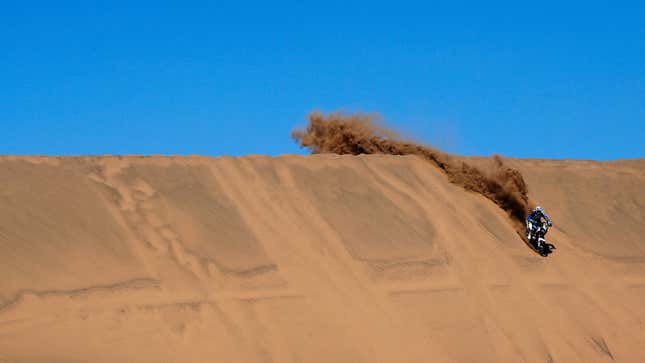Off-roading is a fairly nice pastime that brings individuals collectively, is a enjoyable technique to discover the outside and showcases some unimaginable automotive engineering. Nevertheless, its impression on the pure world shouldn’t be underestimated and now off-road racers have been linked to the destruction of centuries outdated artwork within the Atacama Desert.
A group of historical art work carved into the ground of the Atacama Desert has been broken by tire tracks. The tracks come from vehicles and bikes racing throughout the desert ground, however within the course of they’ve torn by means of 3,000-year-old artworks depicting animals like horses and birds.
Nevertheless, when you may anticipate that the injury was completed by hooligans breaking the countryside code and driving wherever they need, a New York Occasions investigation has discovered that fully-legal off-road races have additionally been permitted to run by means of the artworks.
Lawmakers in Chile have beforehand authorized routes that take racers perilously near the traditional carvings and, whereas the works are mapped out forward of the occasions, little is completed to examine that racers persist with the right traces. As the location explains:
Organizers of 1 massive race, the Atacama Rally, denied any duty for the injury to Alto Barranco, which that they had final raced close to in 2022. Gerardo Fontaine, director of the Atacama Rally, stated that every one members knew their route, had been tracked by GPS and had been alerted in the event that they went astray. He added that the race organizers set the routes, which had been then authorized by the regional authorities.
“The actual problem is with drivers who experience rented bikes within the desert with out permission,” he stated. “Nobody says something to them.”
Daniel Quinteros Rojas, a regional official, authorized the 2022 rally on the situation that the racers persist with pre-established roads. However he stated the rally organizers didn’t flip over GPS tracks adopted by the drivers after the race, so officers couldn’t decide whether or not the drivers brought about might be linked to any noticed injury, Mr. Quintero Rojas stated.
“We discovered an institutional weak spot in our means to watch and handle these impacts,” he stated. For that purpose, he added, no rallies have since been authorized in Tarapacá.
A type of massive weaknesses is that regulators very hardly ever examine GPS monitoring for rivals within the occasion. Actually, one archaeologist that the Occasions spoke with stated that they had filed a grievance with authorities within the area that claimed the rally’s route overlapped with archaeological websites.
As a part of the grievance, they compiled images of racers passing close to the legally protected areas. Whereas no person has been penalized because of the declare, the Atacama Rally relocated for subsequent occasions.

If racers had been to be penalized for driving over the ruins, they’d face fines of as much as $14,500 in Chile. Nevertheless, campaigners have been desperate to level out that figuring out individuals caught driving by means of the works is simpler stated than completed, because the Occasions explains:
At the moment, those that injury archaeological websites in Chile can face greater than 5 years in jail and fines equal to over $14,500, in keeping with the Ministry of Nationwide Property. However José Barraza, the director of cultural heritage for the Tarapacá area, stated that in lots of circumstances, complaints had been dismissed or investigation recordsdata had been left open due to lack of proof, as catching somebody within the act is a problem within the vastness of the desert.
“There aren’t any license plates, no faces,” Mr. Barraza stated.
This doesn’t imply that safety of the works is a misplaced trigger. As a substitute, the Occasions studies that the federal government in Chile has convened a panel of consultants to develop methods to spotlight the artworks’ significance amongst rally racers and put in place a system to shield the undamaged geoglyphs and archaeological areas.


